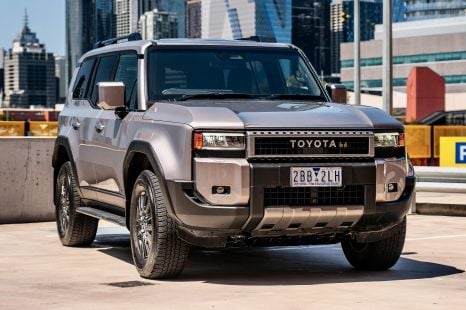

Max Davies
2025 Toyota Prado GXL review
3 Months Ago
The all-electric Volvo EX90 seven-seat SUV stays true to the brand's hallmarks and should carve out a very niche part of the new car market.



Quickly see how this car stacks up against its competition. Select any benchmark to see more details.
Where expert car reviews meet expert car buying – CarExpert gives you trusted advice, personalised service and real savings on your next new car.
Been waiting for an electric Volvo XC90? Meet the new 2025 Volvo EX90…

Yes it wears a slightly different name, but the EX90 joins the smaller EX30 and EX40 in the Swedish brand’s growing lineup of EX-branded EVs, and will soon be joined by the ES90 electric sedan.
The EX90 was also part of Volvo’s ambitious plan to be all-electric by the end of the decade globally – and in Australia by 2026. Those targets have been softened somewhat, and the new EV products will be sold alongside refreshed versions of the brand’s legacy nameplates, which offer mild-hybrid and plug-in hybrid powertrains in the case of the XC90.
Volvo’s new flagship rides on the SPA2 platform shared with the Polestar 3 and ES90. Essentially, it’s a software-driven dedicated electric vehicle platform which builds on the technologies offered by the first-generation Scalable Product Architecture (SPA) platform that underpins the still-current 60 Series and 90 Series ranges in Volvo’s lineup.
It features a big battery pack sourced from CATL, offers a slew of sensors and assistance systems in line with Volvo’s safety-first ethos, as well as the brand’s latest 5G-connected infotainment with Nvidia computing power.
WATCH: Paul’s international launch video review of the Volvo EX90
The EX90 arrives in Australia some 12 months after it was initially due to be released here, following multiple delays. For reference, it was first revealed in production guise back in late 2022.
Has it been worth the wait? We joined the Australian media launch in Adelaide, South Australia, to find out.
The EX90 starts at $124,990 plus on-road costs for the Plus Twin Motor, with the Ultra Twin Motor Performance adding another $10,000.
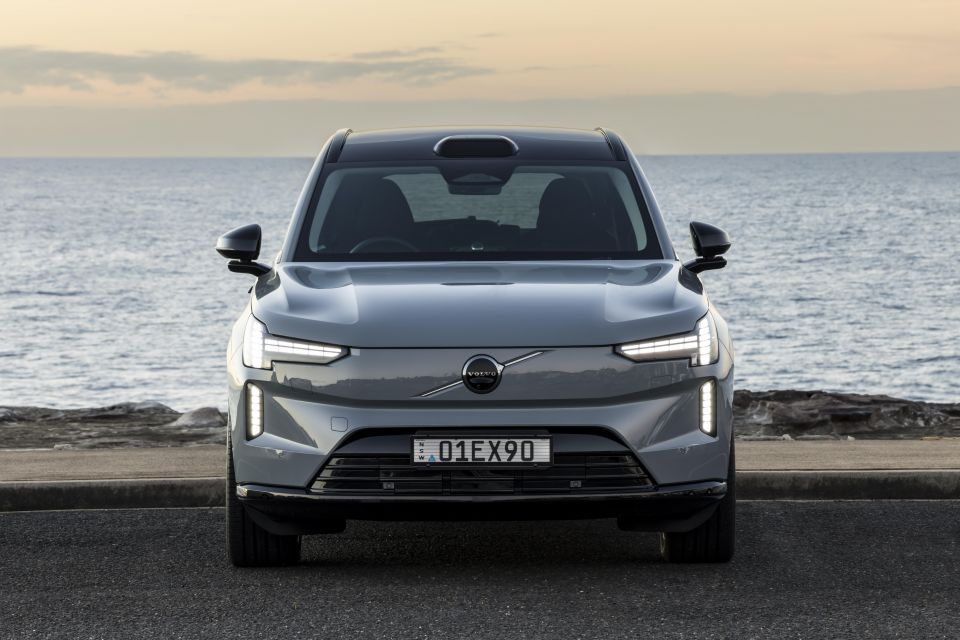
| Model | Price before on-road costs |
|---|---|
| 2025 Volvo EX90 Plus Twin Motor | $124,990 |
| 2025 Volvo EX90 Ultra Twin Motor Performance | $134,990 |
While there’s a new one on the way, the existing XC90 T8 Plug-in Hybrid starts from $128,390 before on-roads, and that’s likely to increase with the incoming facelift due imminently.
However, Volvo’s popular seven-seat SUV starts as low as $99,940 for the entry-level mild-hybrid petrol version. So soon, Volvo will offer mild-hybrid, plug-in hybrid and battery electric seven-seat SUVs in Australia.
The Kia EV9 GT-Line also has similar dimensions and a similarly punchy 283kW/700Nm dual-motor electric drivetrain, and is priced from $121,000 plus on-road costs.
To see how the Volvo EX90 lines up against the competition, check out our comparison tool
Buy your new car without the stress. It's fast, simple and completely free.

Great service from Travis and team, second time I have used this business would not hesitate to recommend them to anyone
Craig C.
Purchased a Ford Ranger in Sunshine Coast, QLD
CarExpert helped Craig save $7,224 on his Ford Ranger, now let us save you on your next new car.
Get your BEST priceVolvo is well-known for its lounge-like cabins, and the EX90 brings that philosophy into a new age.

From the moment I hopped in I noticed a number of shared bits with the Polestar 3, from the steering wheel and driver’s instrument cluster to the floating centre console and even the window switches.
However, Volvo has gone to a lot of effort to make the EX90’s interior look and feel like an evolution of the XC90’s rather than bombarding potential customers with a completely different layout.
The chunky upper dash and door trims are a familiar shape and feel, as is the structure of the dashboard and the shape and feel of the armchair-like seats. Perceived quality and tactility is lovely too, so if you’re wary of the EX90’s Chinese production compared to the XC90’s Swedish assembly, at least first impressions show there’s no downgrade in quality.
What’s new to Volvo – and in a similar vein to the related Polestar – is an even more pared back approach to physical buttons and switches, in some cases to the Volvo’s detriment.
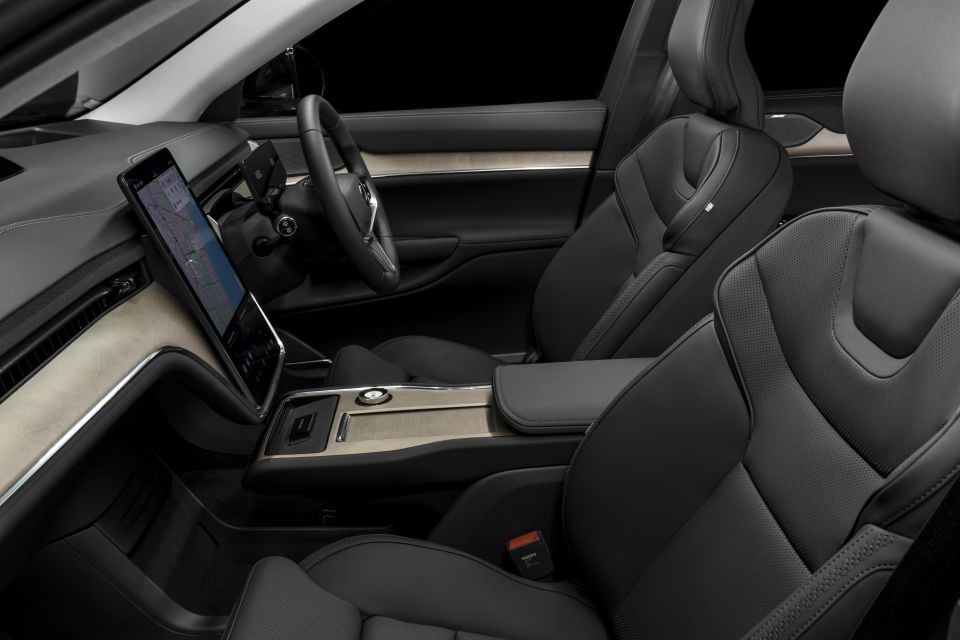

For example, adjustment for the side mirrors and steering wheel requires you to dive through the touchscreen and then use steering wheel buttons. You also have to press a second button to toggle the rear windows as there’s only one actual switch on the front doors.
The removal of the XC90’s drive mode select rocker also grates, as now to change suspension (where applicable) and drive mode settings you also need to dive through the display, which is a bit distracting on the fly.
Ahead of the driver is a slim 9.0-inch digital instrument binnacle that is shared with a number of Geely Auto group models, though the EX90’s one is very close in look and feel to that of the Polestar 3 and 4. It offers a flat and simplistic readout of key info, and has a couple of different views including a Google Maps view.
I appreciate the labelled steering wheel buttons too, which is a key difference to the Polestar 3 despite having virtually the same steering wheel. It aids useability and helps accuracy when you’re driving.
The front seats are typical Volvo in that they’re supremely shapely and supportive, feeling more like comfy lounge chairs than car seats. Electric adjustment and heating are standard, though you can opt for ventilation and massage functions on the base Plus – or get them standard on the Ultra.


Move across the leather-lined and sustainably sourced wood dash and there’s a 14.5-inch touchscreen infotainment system front and centre, plonked on to appear like it’s a floating tablet.
Running the brand’s Google Built-in software interface and connected services, it offers native apps like Google Maps, and Google Assistant as well as access to the Google Play store. Even better, it gets wireless Apple CarPlay and Android Auto as standard – and in our short time with the vehicle, it worked seamlessly.
While some of the convoluted vehicle settings menus add an extra layer to toggling things that I’d prefer weren’t there, it’s not the most convoluted system out there and you have some shortcuts to settings and functions should you need.
The display itself offers beautiful clarity and resolution, with snappy responses to touch inputs as well as buttery smooth loading animations. It also has the Google Assistant built in so you don’t have to manually press anything.
Hooked up to the big iPad-looking screen is a punchy 14-speaker Bose premium sound system in the Plus, but if you want the proper high-end experience there’s an available 25-speaker, 1610-Watt Bowers & Wilkins surround sound system, which is just ace.
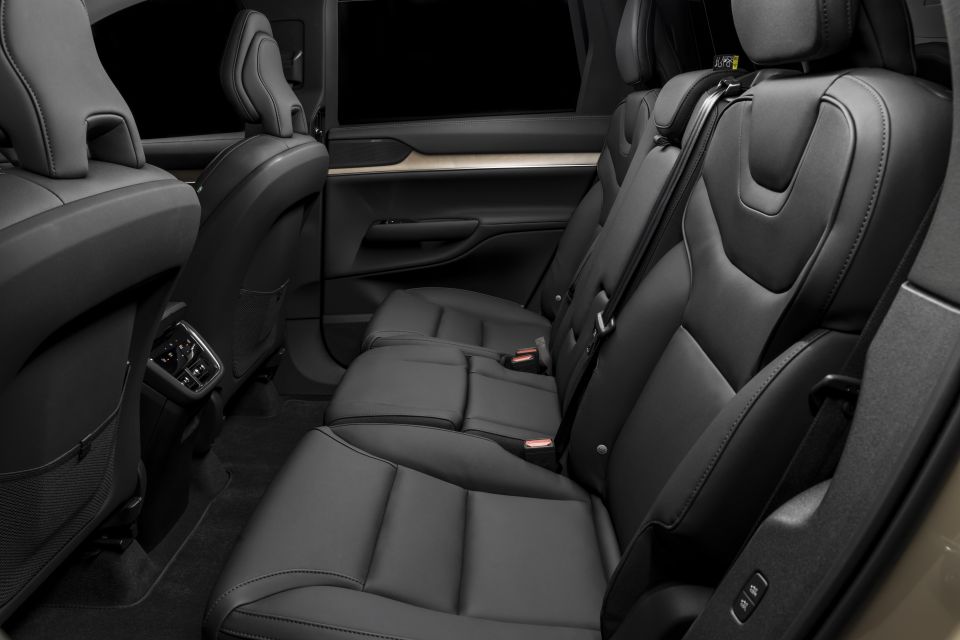

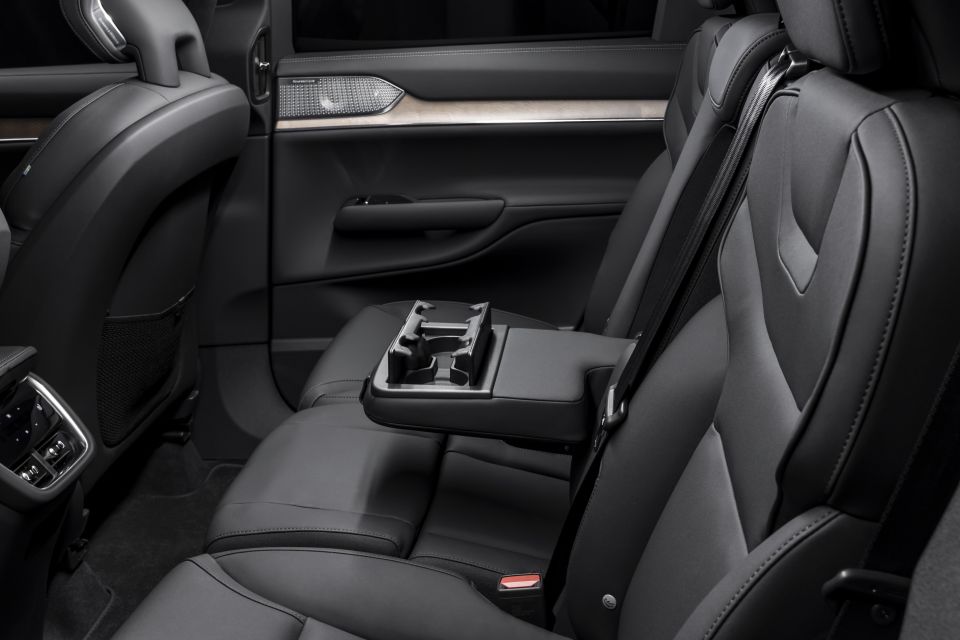
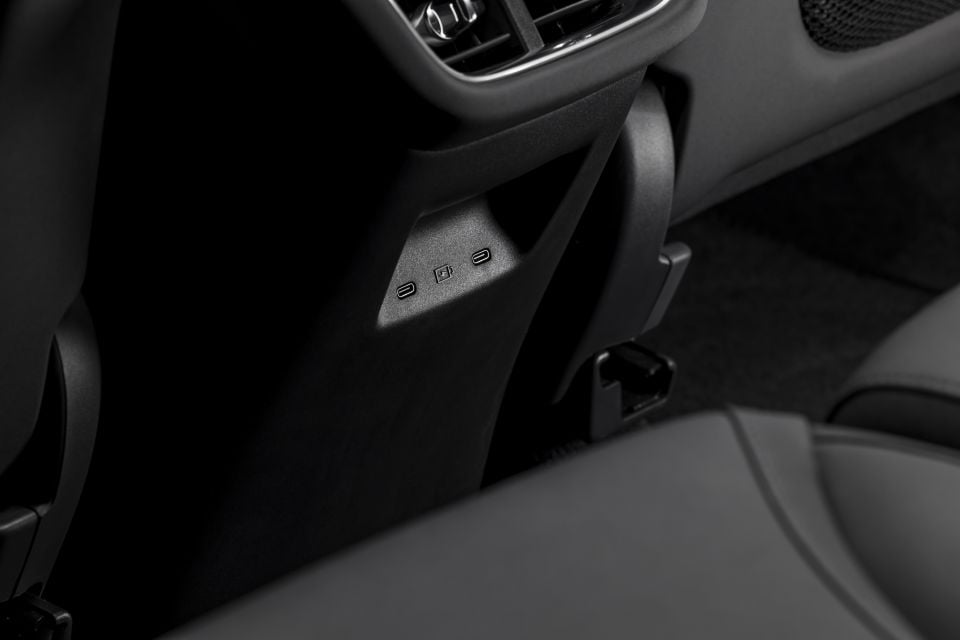
The second and third rows of the EX90 are arguably just as, if not more, important than the first row given this vehicle’s family focus. As standard there are seven seats, though a luxe four-seat Excellence variant is available overseas.
It’s not quite palatial, but second-row accommodation is very good even for above-average adults like myself. At 6’1″, I had plenty of head and leg room courtesy of the boxy proportions, and the front seat backs have scalloped sections to better cater for leggy back seat passengers.
You can slide the second row fore and aft to allow more space in the rear, and each seat individually reclines too. There’s even an integrated booster seat cushion in the centre “for children over four years”.
Four-zone climate control with rear temperature and fan controls is also standard, with vents provided on the rear of the centre console as well as on the B-pillars for added air flow. The EX90 offers a pair of USB-C ports to charge your devices in the rear, bolstering the two up front.
Storage is pretty good all round, with a decent cubby under the front centre armrest, deep door pockets in both rows, space ahead of the front-centre console, map pockets behind the front seats as well as a fold-down centre armrest with cupholders in the second row. Like the XC90, this puts families at front of mind.
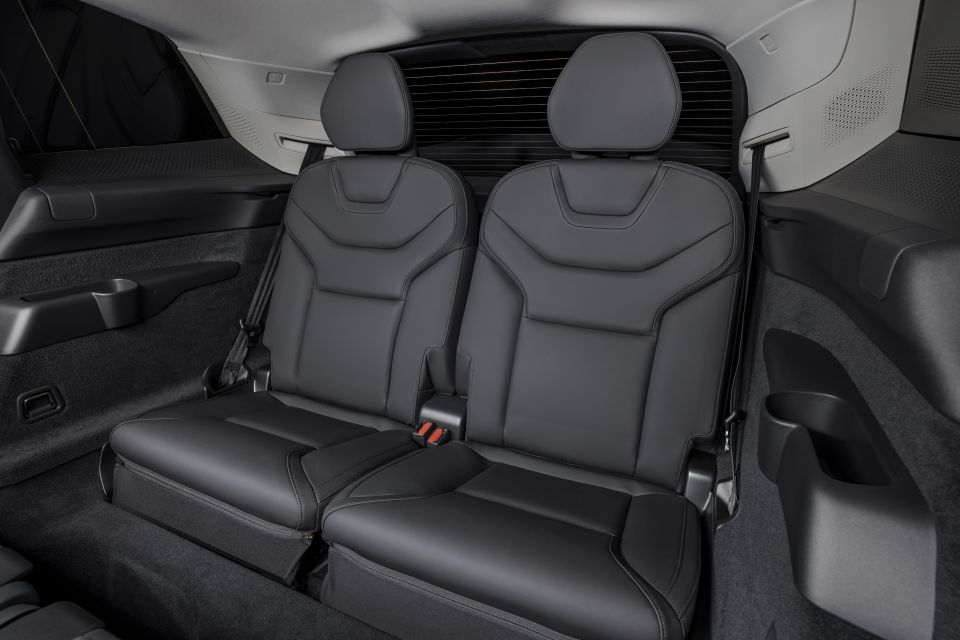
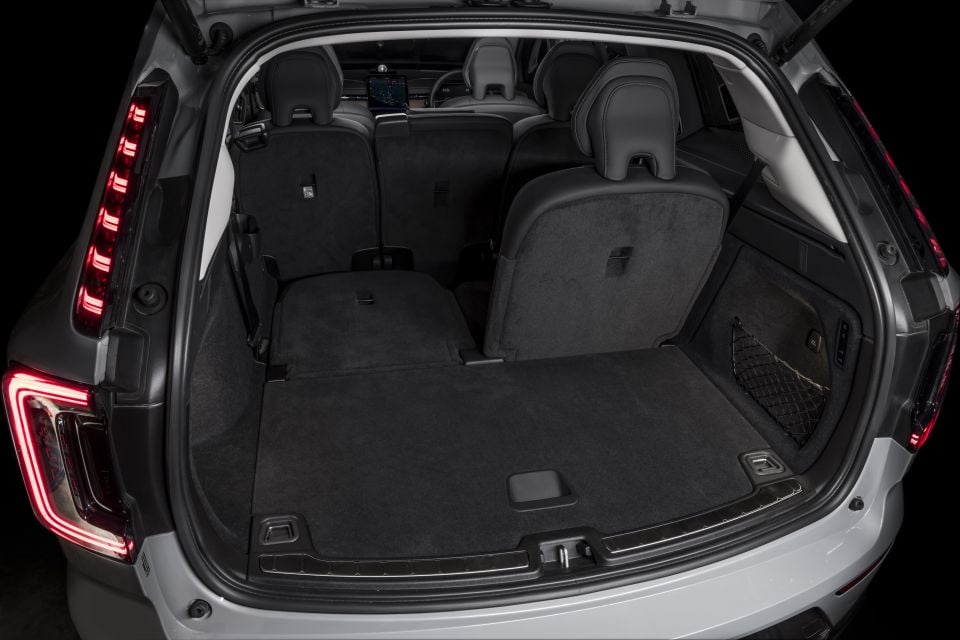
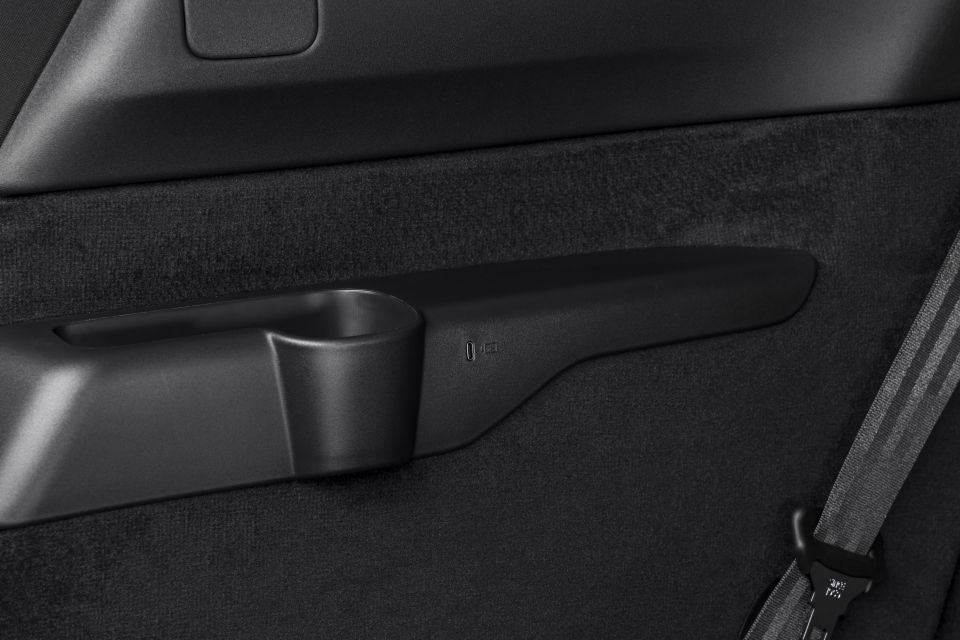
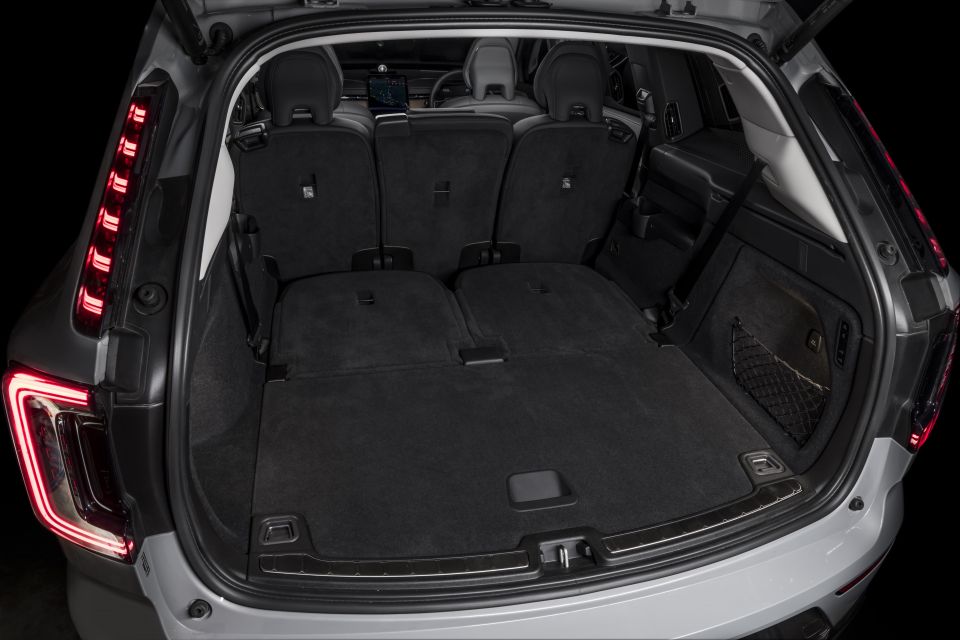
While Volvo describes all seven of the EX90’s pews as “adult-sized seats”, you may want to ensure only adults under 180cm use the third row.
I attempted to slip into the rearmost seats, and found kneeroom in particular to be a challenge. There was doable headroom even for my tall frame, but you’d need to slide the second row forward quite a bit to make it work.
Volvo quotes 310 litres of cargo capacity to the load cover with all seven seats in use, increasing to 655 litres with them folded. Fold the second and third rows and you have 1915 litres at your disposal.
There’s a further 65 litres under the boot floor, which serves as a good spot to store your charging cables, though in lieu of a spare wheel there’s just a tyre mobility kit – something to note if you head out of town often.
| Dimensions | Volvo EX90 |
|---|---|
| Length | 5037mm |
| Width | 1964mm 2113mm incl. mirrors |
| Height | 1744mm |
| Wheelbase | 2985mm |
| Cargo capacity | 310L – 7 seats to load cover 655L – 5 seats to load cover 1915L – 2 seats 65L – under load floor 34L – under bonnet |
To see how the Volvo EX90 lines up against the competition, check out our comparison tool
No combustion engine, but rather a small ‘frunk’ with 34 litres of storage between dividers. The EX90 is available with a pair of dual-motor electric drivetrains in Australia, both fed by a large 111kWh battery.
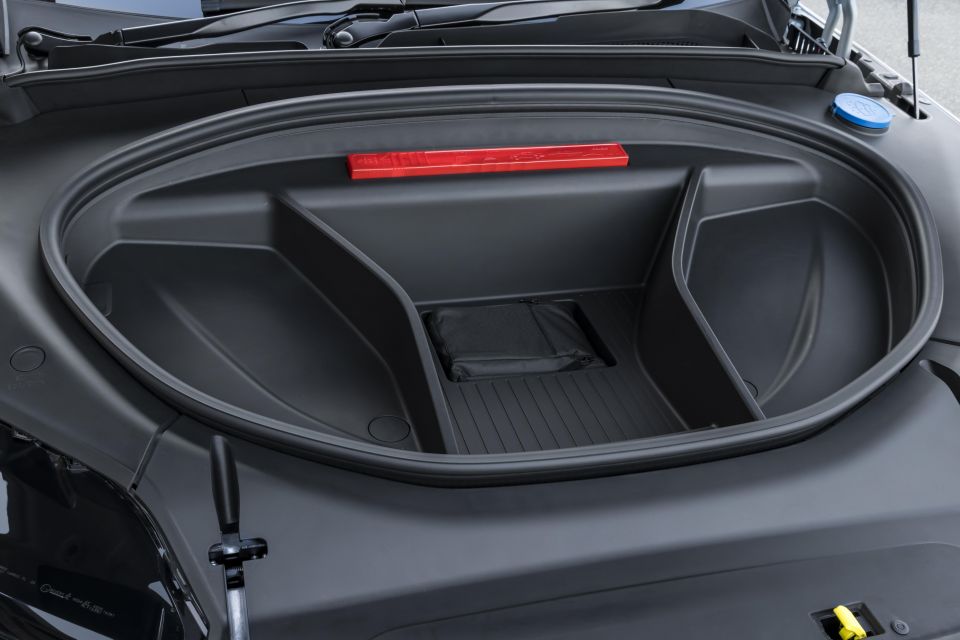
| Specifications | EX90 Twin Motor | EX90 Twin Motor Performance |
|---|---|---|
| Drivetrain | Dual-motor electric | Dual-motor electric |
| Battery | 111kWh – gross Li-ion NMC | 111kWh – gross Li-ion NMC |
| Power | 300kW | 380kW |
| Torque | 770Nm | 910Nm |
| Drive type | All-wheel drive | All-wheel drive |
| Weight | 2807kg | 2815kg |
| 0-100km/h (claimed) | 5.9 seconds | 4.9 seconds |
| Top speed | 180km/h | 180km/h |
| Energy consumption (claimed) | 22kWh/100km | 22kWh/100km |
| Claimed range | Up to 570km – WLTP | Up to 570km – WLTP |
| Max AC charge rate | 11kW | 11kW |
| Max DC charge rate | 250kW | 250kW |
In the EX90 Plus Twin Motor, we were seeing energy consumption closer to the 20-22kWh/100km mark, whereas in the more powerful Ultra Twin Motor Performance that figure was sitting more at the 24kWh/100km with a heavier foot.
To see how the Volvo EX90 lines up against the competition, check out our comparison tool
Volvo is very upfront in that it’s not trying make its cars overtly sporty like some of its premium rivals, instead focusing heavily on comfort and refinement – and that’s all for the better, if you ask me.
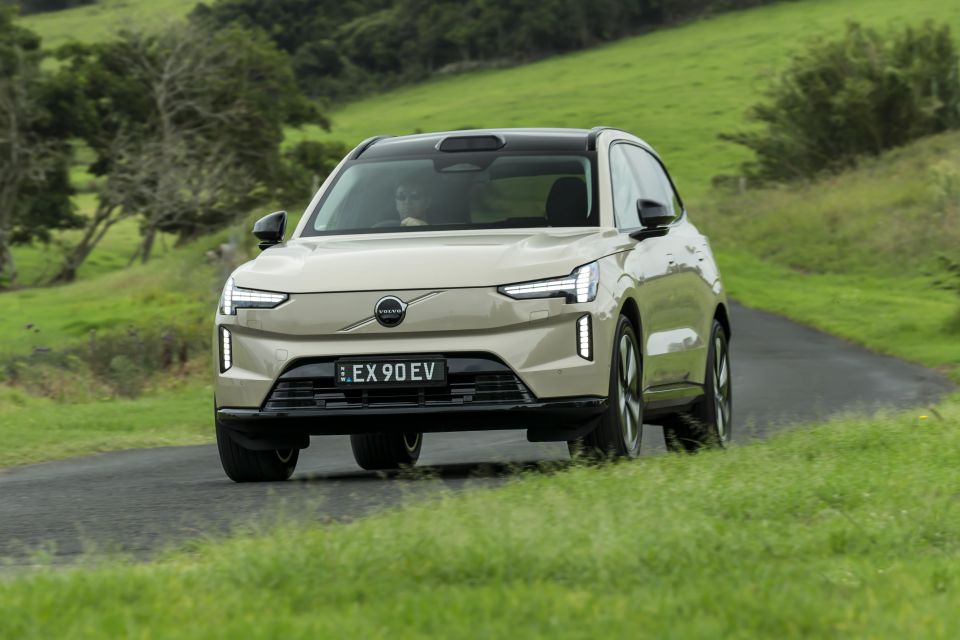
Even the ‘base’ EX90 Plus Twin Motor offers plenty of grunt – quoting 300kW and 770Nm from its dual-motor electric drivetrain – but while it’s capable of hot hatch-beating acceleration, it’s also supremely comfortable and quiet on the move.
Our drive route took us from the Adelaide Airport out to Kington Homestead in the Barossa Valley. The journey saw us tackle inner-city roads and suburbia, before heading out of town onto the freeway and then high-speed country B-roads.
The bulk of our time was spent with the EX90 Plus, which runs a standard steel-sprung suspension setup with passive damping. Riding on the standard 20-inch alloy wheels and chubbier 255/50 Michelin Pilot Sport EV tyres, the standard car strikes a great balance between performance, comfort and handling.
Over undulations and bigger hits, the EX90 is impressively compliant even on the non-adaptive chassis, though we found the initial impact from pockmarked sections of road a little busy and jittery.

Insulation from road and wind noise is excellent, especially given there’s no powertrain noise. Volvo quotes a drag coefficient of 0.29Cd for the EX90, and no doubt the sharply raked windshield and slim mirrors help its cause.
The steering is quick if a little light and vague of feel, making the EX90 remarkably manoeuvrable for such a big rig. Keep in mind this big electric family hauler is over five metres long and nearly two metres wide.
It turns in nicely and offers good grip for such a big and heavy car – it weighs 2.8 tonnes – with good grip from the Michelin rubber even on the more comfort-focused wheel and tyre package.
The EX90 is nicely planted and secure at high speeds, and with the steering in the ‘Firm’ setting isn’t vague about centre. Change it into ‘Soft’, however, and there’s a slight vagueness initially.
Volvo’s 0-100km/h claim of 5.9 seconds seems entirely believable by the seat of the pants, with the EX90 progressively piling on pace at full throttle. It doesn’t snap your neck or make you sick, but gains ground quickly for a big rig.

On the way back to Adelaide from the Barossa Valley we got a shorter stint behind the wheel of the EX90 Ultra Twin Motor Performance, shod with larger 22-inch alloys and adaptive air suspension.
The Performance tune adds another 80kW and 140Nm to the mix, clipping 1.0s from the 0-100km/h time. It certainly feels peppier, though with the air suspension set to ‘Soft’ it adds a little extra float and softness over the passively damped setup.
With those big 22-inch rims and 265/40-section low-profile rubber, there’s still an initial firmness over smaller but sharper impacts, as we experienced in the base model. What did surprise us, though, was that there didn’t seem to be any discernible difference in road noise on the bigger wheels.
Given the Ultra only really adds air suspension, the Bowers & Wilkins surround sound and ventilated seats on top of the added grunt and larger wheels, I’d say you’re better off optioning a Plus with the above features and getting the smaller wheels on air springs – unless you must have the swish HD Pixel LED headlights.
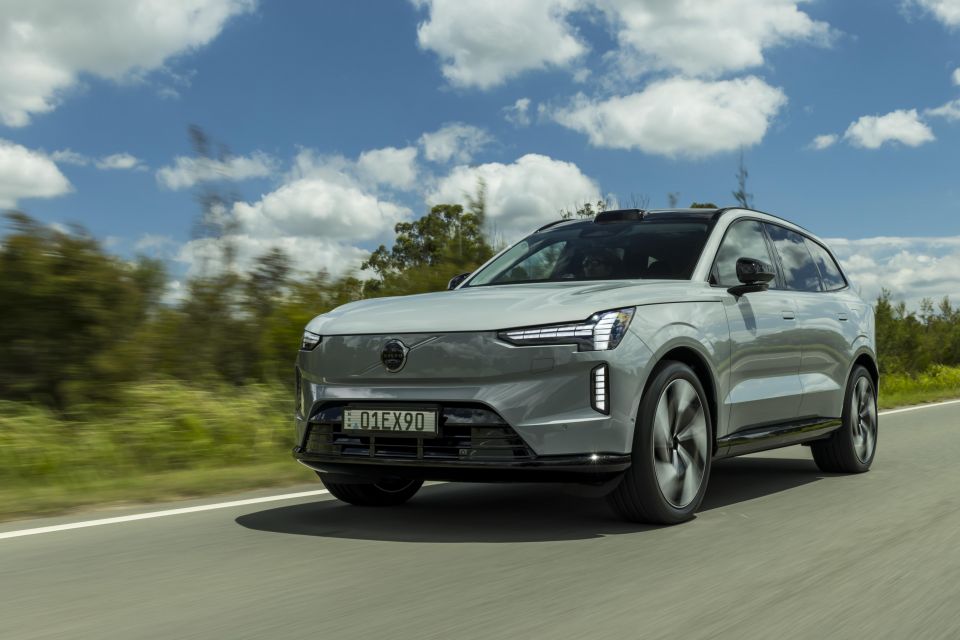
Finally, the driver assistance systems are the most refined that I’ve experienced on this platform and utilising the Geely suite of technologies.
We didn’t experience any bugs or dropouts from the lane sensing systems or driver attention monitor, which in recent experience with Polestar and Zeekr products makes for a lot of annoying beeps and bongs.
The EX90 only vibrates and gently nudges you back into your lane with its lane-keep assist function rather than tugging and jerking the steering out of your hands.
Pilot Assist also worked very well on Adelaide freeways, keeping us centred in our lane and a safe distance from the vehicle in front – though you can’t adjust the set distance. The EX90 can even help you change lanes in this mode if you like.
To see how the Volvo EX90 lines up against the competition, check out our comparison tool
As noted earlier, the EX90 is available in two variants at launch in Australia – Plus and Ultra.
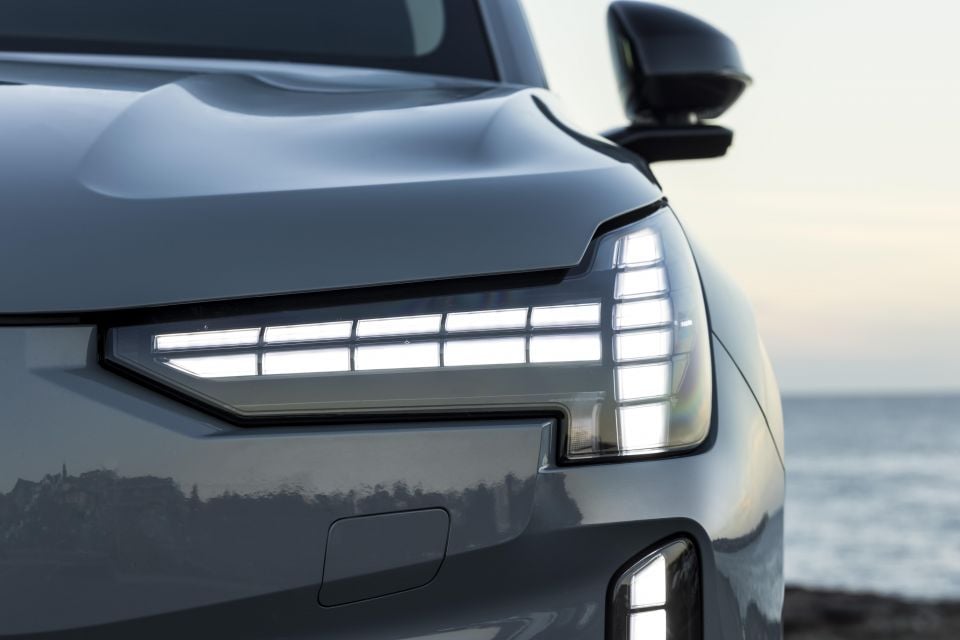

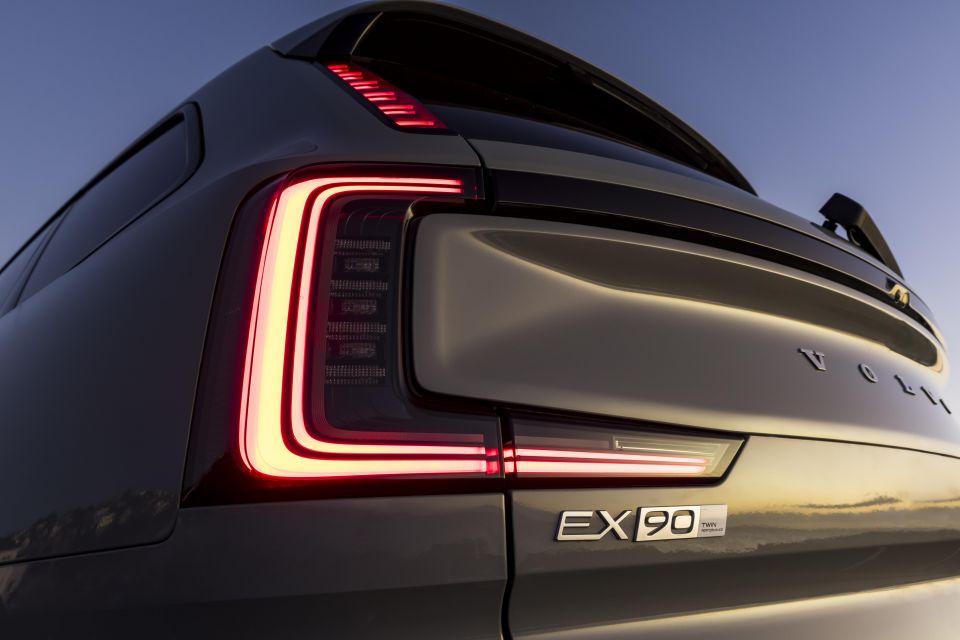
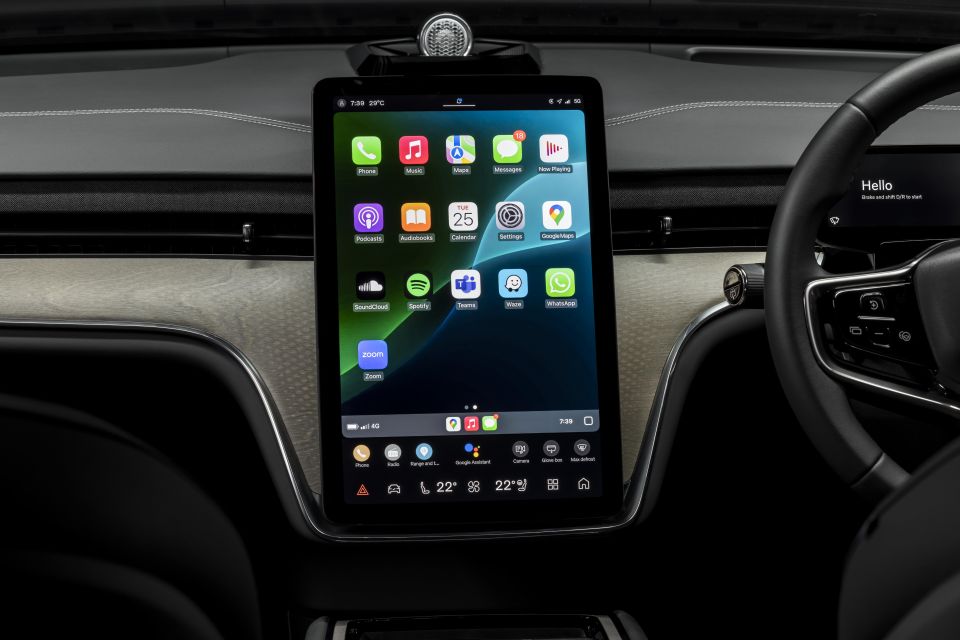
Where expert car reviews meet expert car buying – CarExpert gives you trusted advice, personalised service and real savings on your next new car.
2025 Volvo EX90 Plus equipment highlights:
EX90 Ultra adds:
To see how the Volvo EX90 lines up against the competition, check out our comparison tool
The Volvo EX90 doesn’t currently have an ANCAP or Euro NCAP safety rating.
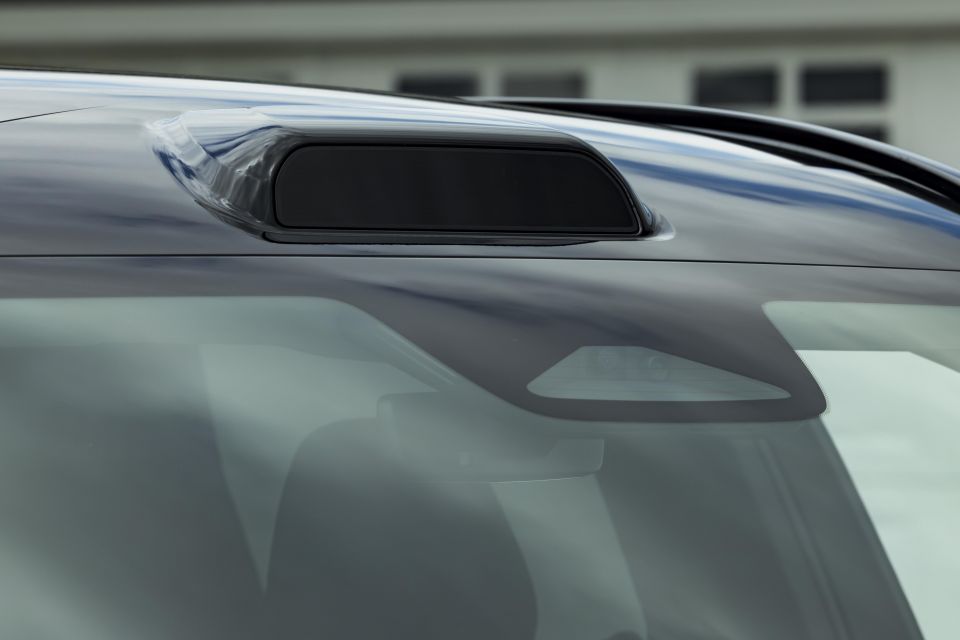
Standard safety equipment includes:
In addition to the above driver assistance systems and technologies, the EX90 offers a suite of external radar sensors and a front-facing Lidar sensor, allowing better detection of other vehicles and road users.
Further, there’s interior cameras for occupant sensing as well as capacitive sensors in the steering wheel to ensure occupants aren’t left behind and that the driver remains in control of the vehicle.
To see how the Volvo EX90 lines up against the competition, check out our comparison tool
The Volvo EX90 is backed by a five-year, unlimited-kilometre warranty, as well as a five-year complimentary service and maintenance package.

| Servicing and Warranty | Volvo EX90 |
|---|---|
| Warranty | 5 years, unlimited kilometres – vehicle 8 years – EV battery |
| Roadside assistance | 5 years |
| Service intervals | – |
| Capped-price servicing | 5 years or 150,000 kilometres |
| Total capped-price service cost | $0 |
Unlike some other premium brands, Volvo doesn’t offer a subscription to public charging networks like Chargefox.
To see how the Volvo EX90 lines up against the competition, check out our comparison tool
Buy your new car without the stress. It's fast, simple and completely free.

Great service from Travis and team, second time I have used this business would not hesitate to recommend them to anyone
Craig C.
Purchased a Ford Ranger in Sunshine Coast, QLD
CarExpert helped Craig save $7,224 on his Ford Ranger, now let us save you on your next new car.
Get your BEST priceIf Volvo’s aim was to have the XC90 pass the baton to the EX90 in its shift to full electrification, it has done a darn good job at moulding the excellent formula laid down by the XC90 for the EV age.
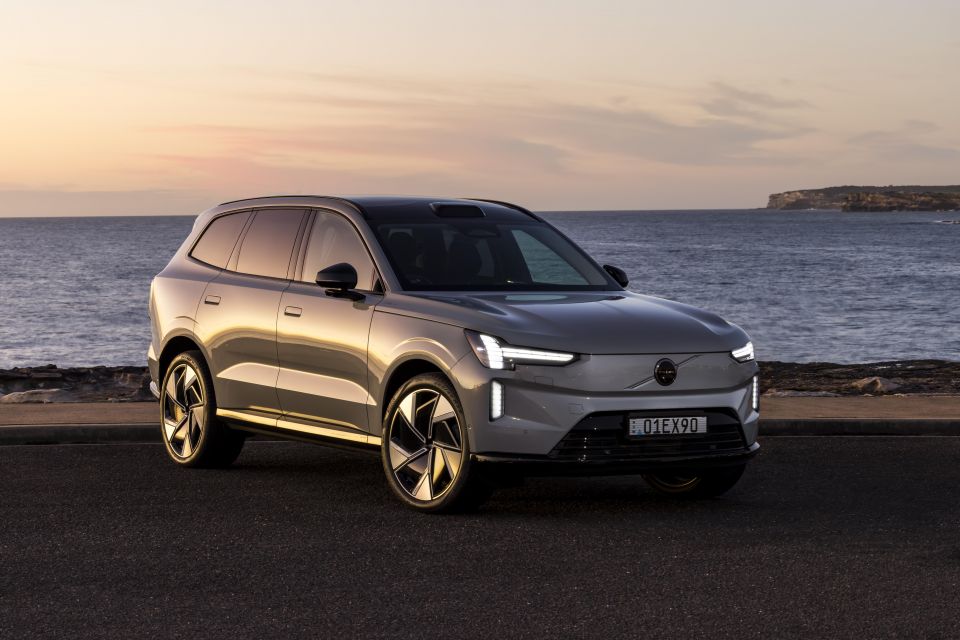
There’s a level of familiarity in the design and layout that existing XC90 owners won’t be overwhelmed by, and it drives like a big, comfy Volvo.
If you’ve ever driven one of the company’s PHEVs, the EX90 is like that but with more electric power and a much longer EV range, without a combustion engine under the bonnet.
Following some quirks with the shared componentry and software of some other Geely brands, the EX90 offers the most refined and capable package of the lot, demonstrating how quickly things can improve with regular updates.
Some small gripes are there though, such as the terse primary ride and the convoluted infotainment menu structure, but the EX90 offers a properly luxurious interior and one of the quietest cabins we’ve experienced.
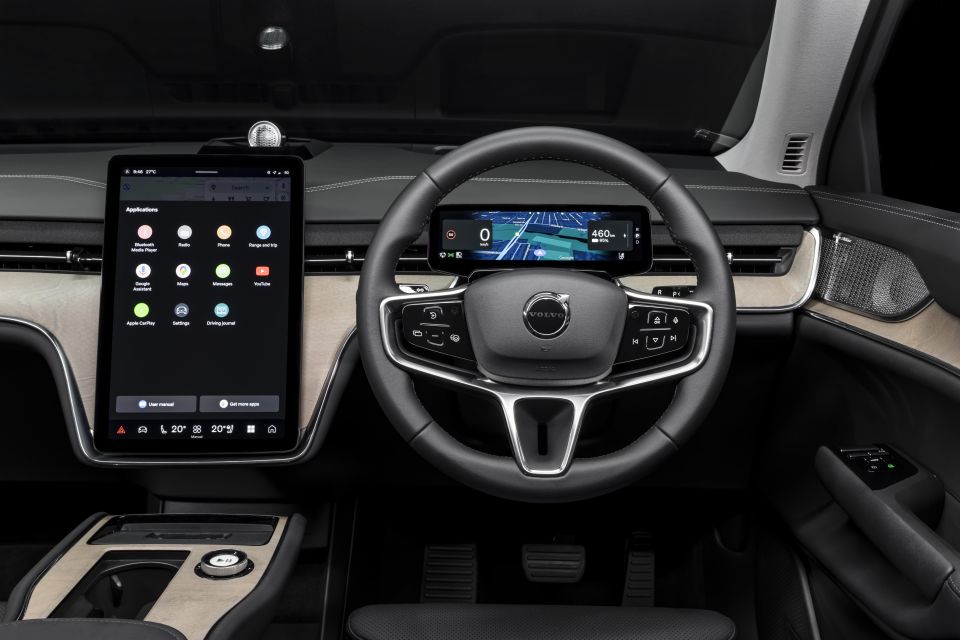
But unlike the XC90, Volvo’s newest flagship has little in the way of direct competition. If you’re wanting a battery-electric large seven-seat SUV, your options are pretty much limited to the Kia EV9 or the Mercedes-Benz EQS SUV.
The Kia, while slightly cheaper, isn’t as premium in its presentation and lacks the badge cachet of the Volvo. Meanwhile, the Mercedes is significantly more expensive – it starts from $197,200 before on-road costs. Similarly sized rivals from Audi and BMW only offer five seats, and likewise cost more.
You could throw in left-field choices like the Zeekr 009, which shares some of the Volvo’s tech but rides on a different platform. It offers even more space and performance but is more expensive again, but I’d wager most SUV buyers perhaps aren’t interested in an MPV or ‘van’.
Volvo has done well then to carve out its own space in the market with the EX90. It’s a worthy new flagship for the Chinese-owned Swedish carmaker, and it showcases everything the brand has to offer without compromising on its core values.

Interested in buying a Volvo EX90? Get in touch with one of CarExpert’s trusted dealers here
Click the images for the full gallery
MORE: Everything Volvo EX90
Where expert car reviews meet expert car buying – CarExpert gives you trusted advice, personalised service and real savings on your next new car.
James is an automotive journalist based in Melbourne, Australia. Before joining CarExpert.com.au in 2020, James has worked at leading auto media outlets including Carsales and CarAdvice, as well as at Pulse agency for Ford Australia's communications team. In 2019 James made Mumbrella's 'Top 20 most prolific web authors in Australia' list after publishing 1,360 articles between March 1, 2018 and February 28, 2019 for CarAdvice. James is also an Ambassador for Drive Against Depression – an Australian charity whose mission is to support mental wellness through the freedom of driving and a shared love of cars.


Max Davies
3 Months Ago
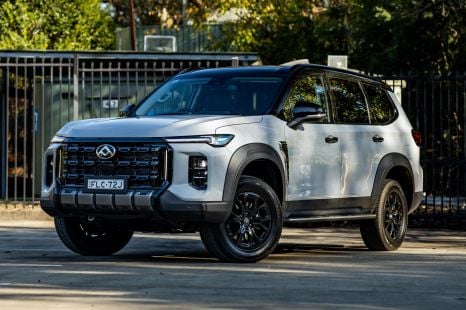

Matt Campbell
2 Months Ago
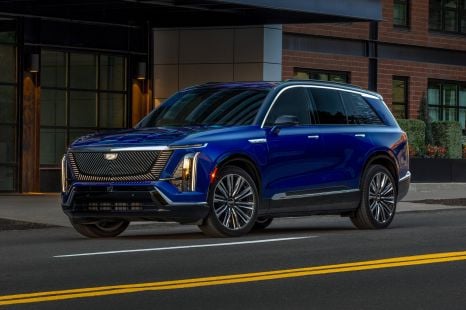

William Stopford
2 Months Ago


Josh Nevett
2 Months Ago
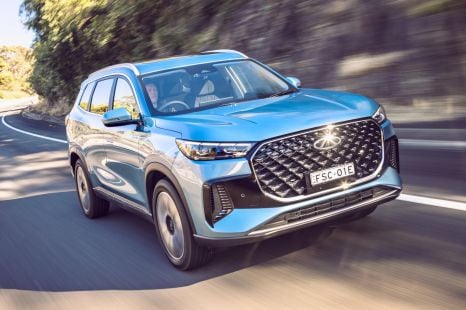

Max Davies
1 Month Ago
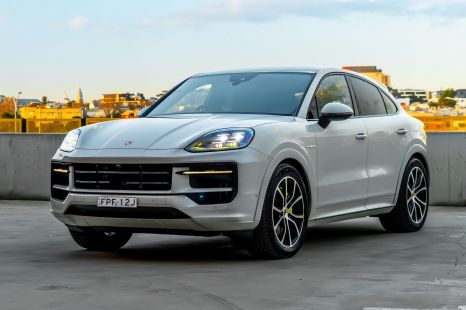

James Wong
26 Days Ago